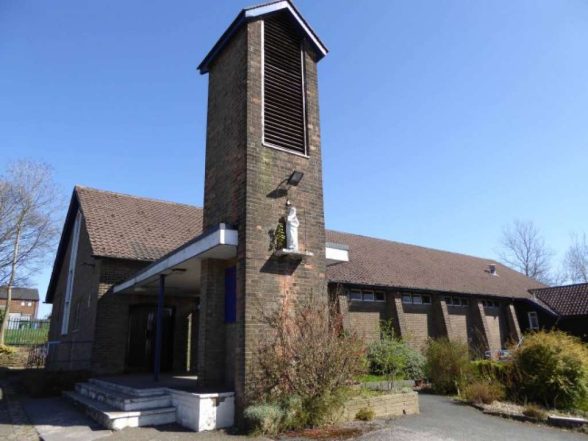This website uses cookies
This website uses cookies to enable it to function properly and to analyse how the website is used. Please click 'Close' to accept and continue using the website.



Image: Estate of George Mayer Marton
The Roman Catholic Church of the Holy Rosary in Oldham and its ‘transcendental’ Crucifixion mural have been Grade II listed, after an application by C20 Society and a campaign by SAVE Britain’s Heritage.
The church was built to designs by W & J B Ellis and Partners in 1954-55 to serve the large post-war housing estate of Fitton Hill on the south side of Oldham, Greater Manchester. The east wall of the sanctuary is covered by a striking mural commissioned from the Hungarian-Jewish émigré artist, George Mayer-Marton. A rare combination of glittering stone and glass tesserae for its depiction of Jesus on the cross, flanked by blue monochrome frescoes of Mary and St John, it stands some 8 metres (26 feet) high and is one of only two ecclesiastical murals by Mayer-Marton to survive in situ.
Historic England’s report states: “The mural is highly unusual and possibly unique in this country, in its striking aesthetic combination of neo-baroque mosaic and modernist Cubist-influenced fresco inventively applied to traditional Christian iconography in a deeply personal evocation of suffering and redemption.”

Image: Modern Mooch
A six-year campaign to protect the mural, led by the artist’s great-nephew Nick Braithwaite, gained extra urgency after the artwork was damaged as a result of vandalism in recent weeks.
First assessed for listing shortly after it closed in 2017, the church was initially rejected for not demonstrating sufficient architectural merit. After being unsympathetically painted over with white emulsion by a local priest at some point in the 1980’s, the mural was also thought to be compromised and no longer intact.
However subsequent trials in 2019 and 2021 have shown that the fresco survives under the emulsion paint, its original design and intensity of colour still visible. In light of this new information, the Church of the Holy Rosary has now been reassessed for listing, with a retrieval and restoration of the mural believed to be technically possible.

Mayer-Marton was a Hungarian Jew, born in Gyor in 1897. After serving in the Austro-Hungarian army in the First World War, he studied art at academies in Vienna and Munich, and Byzantine mosaic in Ravenna.
Settling in Vienna, he became the vice-president of the important and progressive Hagenbund group of artists between the Wars, who had an interest in the unity of architecture and art seen in the British Arts and Crafts movement and the German-Austrian tradition of Gesamtkunstwerk (total work of art linking painting, architecture, word and music).
In 1938, following the Anschluss (annexation of Austria by Germany), Mayer-Marton and his wife fled to Britain; the Nazis subsequently destroyed all his pre-war frescoes in Austria and his family, who remained in Hungary, perished in the Holocaust. While in London in 1940 his studio was hit by an incendiary bomb destroying much of his work. Mayer-Marton worked as a lecturer for the Council for the Encouragement of Music and the Arts (CEMA), predecessor of the Arts Council until 1952. He was then appointed senior lecturer at the Liverpool College of Art where he established the Department of Mural Art, the first of its kind in Britain. After his appointment, Mayer-Marton received a number of ecclesiastical commissions across the country, today his artworks are held in collections including the British Museum, the V&A and the Scottish National Gallery.
C20 and SAVE Britain’s Heritage will be leading a very special visit to view the mural next month. While the event is now sold out, you can still add your name to the waiting list should any more places become available.

Become a C20 member today and help save our modern design heritage.